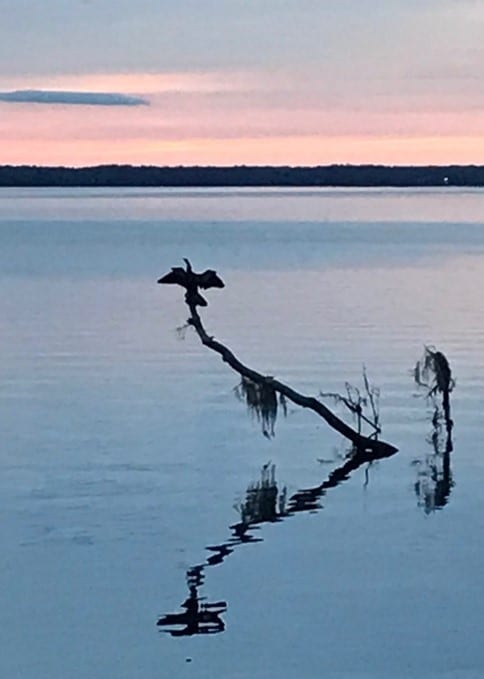The anhinga (Anhinga anhinga) also known as the snake bird or water turkey, is a year-round Florida resident. They inhabit aquatic and marine ecosystems that include the Atlantic Ocean, Intracoastal Waterway and the St. Johns River. Their range is South Carolina westward to Texas and Mexico, and even south through Amazonia to Argentina. Their name, anhinga, comes from a Brazilian Indian tribe, meaning “devil bird” or “evil spirit of the woods.”
You can often spot the anhinga perched on a branch with wings outstretched, drying feathers. They feed on small fish, shrimp, amphibians, tadpoles, crayfish and young alligators and snakes. The fact that they have dense, heavy bones and feathers that are less water resistant than other birds helps them to swim underwater, where they often spear fish with their long neck and sharp beak. They surface in order to flip their catch into their mouth for consumption.
According to Travels published in 1791, Bartram encountered these birds many times in his explorations particularly along the St. Johns River and the Atlantic Intracoastal Waterway, near St. Augustine in 1774. Below is his interpretive description. There may have been some confusion with the cormorant, another aquatic bird that inhabits the same ecosystems. Because the cormorant has a much broader North American range, Bartram was likely familiar with them from his Northeast colonies travels before the Southeast. Neither bird was sketched. However, John James Audubon painted the anhinga in 1822 from a specimen in New Orleans Louisiana. He went on to paint the cormorant in 1832 down in the Florida Keys.


Bartram’s 1791 published description better fits the anhinga, “Here in this river and in the waters all over Florida, a very curious and handsome bird, the people call them Snake Birds, I think I have seen paintings of them on the Chinese screens and other India pictures: they seem to be a species of cormorant or loon (Colymbus cauda elongata) but far more beautiful and delicately formed than any other species that I have ever seen. The head and neck of this bird are extremely small and slender, the latter very long indeed, almost out all proportion, the bill long, straight and slender, tapering from its base to a sharp point, all the upper side, the abdomen and thighs, are as black and glossy as a raven’s, covered with feathers so firm and elastic, that they in some degree resemble fish scales, the breast and upper part of the belly are covered with feathers of a cream colour, the tail is very long, of a deep black, and tipped with a silvery white, the tail is very long, of a deep black, and tipped with a silvery white, and when spread represents an unfurled fan.
“They delight to sit in little waters, with their wings and tails expanded, I suppose to cool and air themselves, when at the same time they behold their images in the watery mirror: at such times, when we approach them, they drop off the limbs into the water as if dead, and for a minute or two are not to be seen; when on a sudden at a vast distance, their long slender head and neck only appear, and have very much the appearance of a snake, and no other part of them is to be seen when swimming in the water, except sometimes the tip end of their tail. In the heat of the day, they are seen in great numbers, sailing very high in the air, over lakes and rivers.”
See the UF IFAS video link below outlining anhinga and cormorant characteristics and differences. Now you know some natural history of them and can correctly identify these amazing aquatic swimming and fishing birds!
